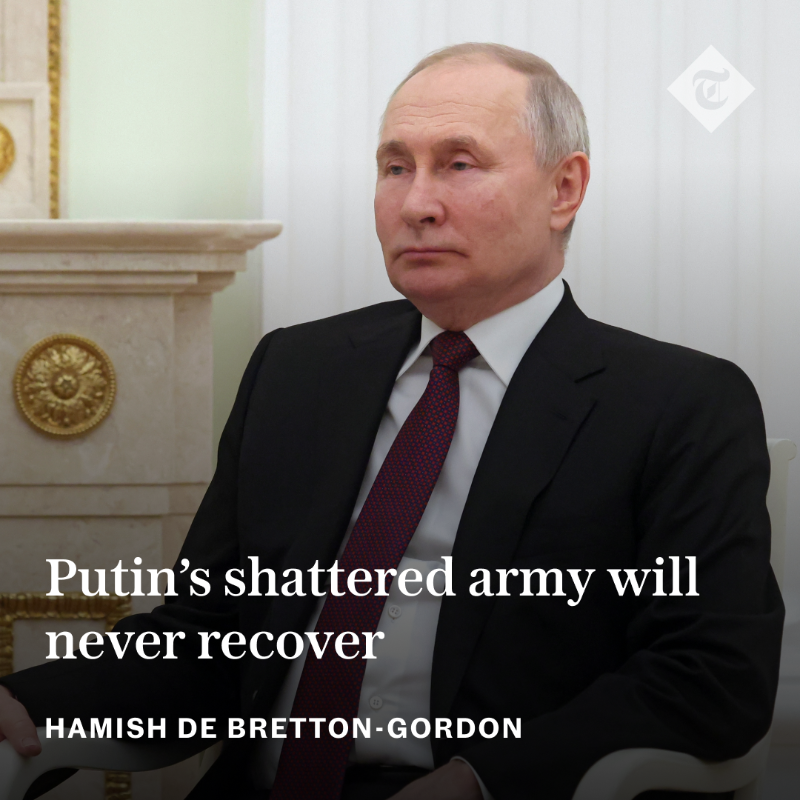Hamish De Bretton-Gordon
It was the 19th-century military theorist Carl von Clausewitz who described war as “the realm of uncertainty”. In Ukraine, the fog of war is thick, and growing ever thicker. It’s impossible to gauge the true state of the battles raging in the east of the country. For some, Ukraine’s heroic defence against the renewed Russian offensive marks a victory of sorts. For others, the high losses they are sustaining are indicative of Russia’s ability to remobilise and regroup.
But if the latest information coming out of Russia is to be believed, Putin and his generals are in a worse state than many realise. In a bizarre twist, the Russian army appears to be morphing into the Red Army of yesteryear, with trains spotted carrying 1950s T55 tanks to the front line, hurriedly lifted out of storage. It is the latest sign of a serious, perhaps fatal, armour shortage among Putin’s forces. As a former tank commander, I cannot overstate the insanity of sending such outdated heavy weaponry to the front – the Russians must be truly desperate. Either that or they have lost the plot.
In the 21st century, these old tanks are little more than steel coffins. A modern rifle could pierce their armour; a drone or modern Western tank could do far worse. To a “tankie” like me, it’s the equivalent of a First World War biplane taking on a new stealth fighter. If I was a Russian tank commander – God forbid – and my commanding officer told me to fight in one of these museum pieces, I would stand to attention, turn to the right, salute, and march home. The problem is that the Russian generals still believe their own propaganda. They believe in the myth of the indestructible Soviet tank rolling across Europe. Before the invasion, Russia’s minister of defence, Sergei Shoigu, invested heavily in a fleet of modern tanks when he reformed the armed forces. Their effectiveness was impeded by corruption, however, and then they were largely destroyed in the initial invasion last year. Once they were gone, they were gone for good and impossible to replace. I said at the time it was hard to see how the Russians could ever truly recover; so it has proved. And far from giving the Russians any chance of victory, these relics will only hasten their defeat.
Critics of my view will argue that it’s quantity not quality that matters; that even these relics in large numbers are a daunting prospect on the battlefield. Nonsense. One need only study the Battle of Kursk in 1943 – the largest tank battle in history – to see the folly of sending large numbers of old tanks against superior models and advanced anti-tank weaponry. The Russians lost many hundreds of T34s in that hideous battle, yet 80 years later they want to use outdated tanks against even more modern technology. It’s lunacy. When Britain’s Challenger 2s arrive in Ukraine, they will pick off T55s as though in a fairground shooting gallery. And even if these Soviet tanks managed to hit a Challenger 2, it’s likely the crew wouldn’t even notice. A British tank round would probably go through two or three of them before it ran out of energy. It now makes complete sense why the Russians are trying to frame the rounds we are donating as biohazards (made as they are with harmless depleted uranium). They know they will decimate their “new” tank battalions, which will not be able to land a punch back.
At this vital moment, as certain Western countries equivocate about their continued support of Ukraine, it is important we don’t buy into Putin’s propaganda that Russia is remobilising so many men, munitions and materiel that it will be ultimately unstoppable. It is simply not true. The core of the Russian army is broken and unrecoverable. Its advanced tanks are wrecks and its men exhausted, unable to advance more than a few miles a week in this new push. In short: it will take years for Russia to rebuild – time it does not have as the new wave of Western weapons begins to arrive. If tanks designed many, many decades ago are what Russia is resorting to, we should station guards at the Tank Museum in Dorset in case the Russians try to steal them. They would be better use than the ones Putin is now bringing out of storage to relieve his beleaguered forces.
The Telegraph







